Internal Medicine: Open Access
Open Access
ISSN: 2165-8048
+44 1300 500008
ISSN: 2165-8048
+44 1300 500008
Research Article - (2022)Volume 12, Issue 2
Introduction: The coronavirus disease is caused by Severe Acute Respiratory Syndrome Coronavirus 2 (SARS-CoV-2) and declared to be transmitted from human-to-human. This transmission takes place through multiple means like the aerosols, fomites and droplets. In dentistry, dental ultrasonic devices and high-speed hand pieces, mainly when used with water, commonly produce the fine aerosols. These aerosol particles can remain suspended in air then land on adjacent surfaces within the dental office, which includes the personal protection equipment. Therefore, the aim of the present study was to make a survey on Dental practitioners concerning the perceived risks of aerosol contamination in COVID-19 times and their attitude toward modifications of treatment protocols to reduce this risk.
Objective: The objective of the present study was to make a survey on Dental practitioners concerning the perceived risks of aerosol contamination in COVID-19 times and their attitude toward modifications of treatment protocols to reduce this risk.
Materials and methods: The present cross sectional descriptive study was conducted among dental practitioners. The survey was conducted on an online forum using google form. The questionnaire included questions related to fine aerosols and perceived risks of aerosol contamination in COVID-19 along with sociodemographic factors such as age, gender and year of study. Descriptive statistics were expressed by means of frequency and percentage. Chi Square test was used to find the association between the variables. P value less than 0.05 were considered to be statistically significant.
Results: From our survey we can witness about 60% of the participants had increased fear of perceived risk of COVID-19 among dental practitioners. Considering the categories more at risk in the dental settings, the majority 50% of respondents thought that the dentists were undergoing highest risks, while only the 19% of respondents considered patients to be the ones more at risk; and about 30% of respondents believed risks to be equally divided between patients and dental professionals.
Conclusion: From the survey we may conclude that the survey demonstrated that COVID-19 had a great impact on dental practitioners; it increased not only fear of aerosol contamination during dental treatments but also influenced the fear of close contacts.
COVID-19; Fine aerosols; Perceived risks; Dental practitioners; Innovative analysis
Wuhan, a city in China was the first to report the coronavirus disease in December 2019. The coronavirus disease is also known as the COVID-19. The coronavirus disease is caused by Severe Acute Respiratory Syndrome Coronavirus 2 (SARSCoV- 2) and declared to be transmitted from human-to-human. This transmission takes place through multiple means like the aerosols, fomites and droplets. Coronavirus infection is a common onset of infection with fever, cough and fatigue which later triggers severe acute respiratory illness [1]. Infectious agents that cause this COVID disease usually spread from their natural reservoir to a susceptible host in different pathway systems. It has classified the virus transmission which includes the humanhuman transmission, airborne transmission, and also by other modes of transmission such as endogenous infection, common vehicle, and vector spread. Many viruses that affect the respiratory system of humans are believed to transmit through multiple routes, of which droplet and aerosol transmission paths are in supreme positions, but their importance in transmitting the disease remains unclear. In common, people that are infected with the virus usually spread the viral particles whenever they indulge in talking, coughing, sneezing or even during breathing. Such viral particles which spread from a human are usually known to be encapsulated in globs of mucus, saliva, and water [2]. COVID-19 was declared as a pandemic and highly contagious disease, 120 days after the first reported case. As of May 05, 2020, worldwide there have been more than 3.5 million confirmed reported cases and 243,401 deaths by the coronavirus disease worldwide [3-7].
In dentistry, dental ultrasonic devices and high-speed hand pieces, mainly when used with water, commonly produce the fine aerosols. The Fine aerosols are a mixture of moisture droplets, spatters of often blood-contaminated saliva and debris. These aerosol particles can remain suspended in air then land on adjacent surfaces within the dental office, which includes the personal protection equipment. The dimensions of these aerosol particles are very small (generally 5 microns or less in diameter), and these particles are difficult to be seen on surfaces. It has been illustrated that without using proper protection like the personal protection equipment kits, these aerosol particles can directly infect and affect the dentists and dental assistants nearby. These particles affect the dentists by reaching the eyes, the facial skin, and mucous membranes of the mouth, as well as respiratory passages up to the depths of the lungs [8].
There have been experimental studies that have proven that highly dangerous bacteria, like the Mycobacterium tuberculosis, can also be found in fine aerosol particles generated during simulated use of high-speed hand pieces on patients with active tuberculosis. However, any infectious particles in fine aerosols are known to contaminate surfaces and personal protection equipment in the dental offices, thus they require special focusing attention during decontamination of surfaces and removal of PPEs [9]. These observations resulted in the adoption of universal barrier precautions and effective methods of infection control in all dental offices as routine procedures during the treatment of all patients, to prevent contamination from both airborne and blood infections [10].
The recent huge outbreak of coronavirus infection has generated profound attention from governments worldwide. Dental practitioners and the public are both concerned due to the potential transmission of the COVID-19 disease in the dental setup. Hence governments of various countries promoted rules and also recommended to suspend all the routine dental treatments during this crucial pandemic period [11]. Dentists had to organize necessary and urgent treatment procedures only by implementing appropriate safety measures to avoid the risk of coronavirus infection. Measures to reduce or avoid the production of minute droplets and fine aerosols were highly suggested. In such highly unprecedented times, different instructions from the various scientific organizations and governments around the world, and a profound economic downturn due to the full or partial closure of dental offices, a general anxiety is growing among dentists [12].
Besides the negative economic impact on their incomes, when so little is known about COVID-19 contamination, survival in the air or on surfaces, contagion from asymptomatic patients, with often limited or contradictory scientific information provided, practitioners are worried about the patients’ safety as well as their own one.
Our team has extensive knowledge and research experience that has translate into high quality publications. The aim of the present study was to make a survey on Dental practitioners concerning the perceived risks of aerosol contamination in COVID-19 times and their attitude toward modifications of treatment protocols to reduce this risk.
A cross-sectional study was conducted across the dental practitioners in Chennai. A structured questionnaire was created using Google Forms in English and was distributed using social media appliances like Whatsapp and other appliances such as emails. The questions were directed towards analyzing the perceived risks of aerosol contamination in COVID-19 times. It took about 5-10 minutes to complete the survey. The total numbers of participants were 150 dental practitioners. Participation in this study was voluntary. Nonprobability convenience sampling with minimal sampling bias was done. Independent variables were demographics such as the age, gender of the participants. Dependent variables were the participant should be a dental practitioner [13].
With the help of the survey portal, the results were obtained and tabulated using Microsoft Excel Spreadsheet. The data was then analyzed using SPSS software by IBM (Version 23), statistical software with defined variables. Significance of the study was obtained using chi-square test and results were interpreted p<0.05 was set as the level of significance [14].
Among the 150 respondents, 56.7% of the participants were pg graduates and 43.3 % of the participants were ug graduates; 54.7% of the practitioners had less than 5 years of experience, and the remaining 45.3% of the practitioners had more than 5 years of experience.
Overall, 60.7% of dentists consider the dental settings more dangerous for the diffusion of COVID-19 than other social behaviors (i.e., going to food markets, restaurants, and beauty salons, etc.) (Figure 1). Considering the categories more at risk in the dental settings, the majority 50% of respondents thought that the dentists were undergoing highest risks, while only the 19% of respondents considered patients be the ones more at risk; and about 30% of respondents believed risks to be equally divided between patients and dental professionals (Figure 2) [15].
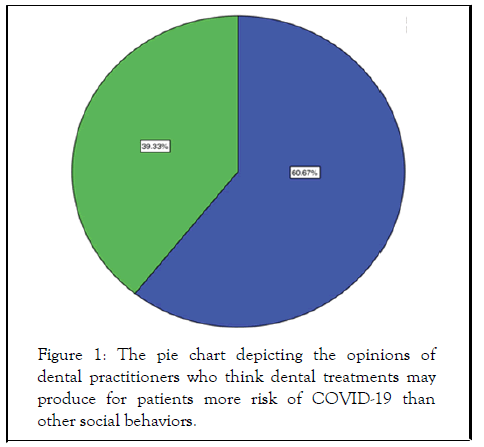
Figure 1: The pie chart depicting the opinions of dental practitioners who think dental treatments may produce for patients more risk of COVID-19 than other social behaviors.
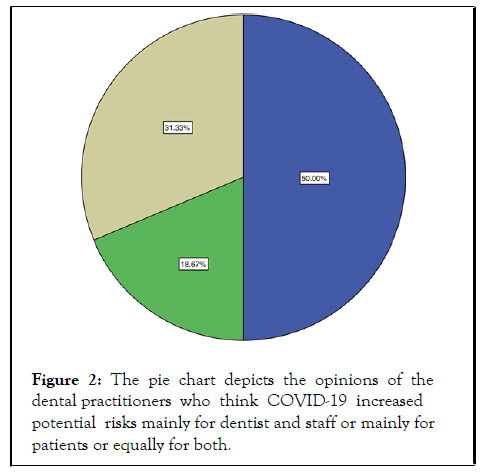
Figure 2: The pie chart depicts the opinions of the dental practitioners who think COVID-19 increased potential risks mainly for dentist and staff or mainly for patients or equally for both.
Fine aerosol producing treatments are perceived as an increased risk by the majority (56%) of dentists (Figure 3), but there is not a real consensus on which one, between direct aerosol (28%), non-direct aerosol (34.7%), and close contacts (37.3%), is the most dangerous way of transmission of infection (Figure 4). Most of the dentists (37.3%) favored implementation of protocols to avoid/reduce in-office COVID-19 infections (Figure 5). Thus almost 62% of our participants think that COVID-19 has changed their perception of infection risks in a dental office (Figure 6).
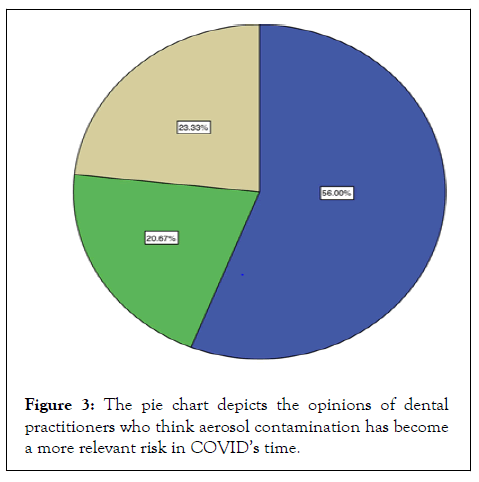
Figure 3: The pie chart depicts the opinions of dental practitioners who think aerosol contamination has become a more relevant risk in COVID’s time.
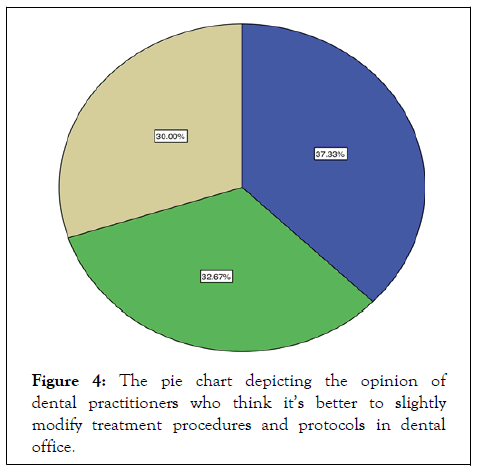
Figure 4: The pie chart depicting the opinion of dental practitioners who think it’s better to slightly modify treatment procedures and protocols in dental office.
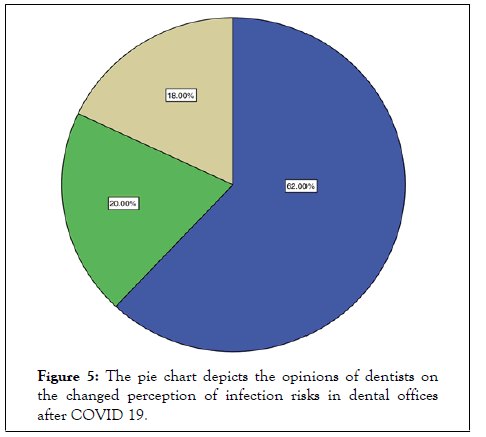
Figure 5: The pie chart depicts the opinions of dentists on the changed perception of infection risks in dental offices after COVID 19.
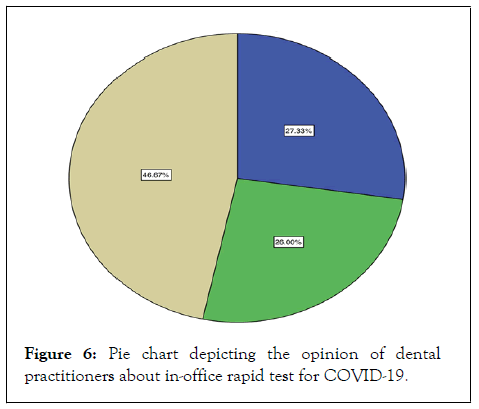
Figure 6: Pie chart depicting the opinion of dental practitioners about in-office rapid test for COVID-19.
The correlation between qualification of the dental practitioner and their perceived risks of aerosol contamination in COVID-19 times shows that PGs show more perceived risk of fine aerosols. The correlation between qualification of the dental practitioner and aerosol contamination became a more relevant risk in COVID’s time shows that Ugs think that aerosol contamination has become a more relevant risk in COVID’s time [16,17]. The association of qualification of the dental practitioner towards the thoughts on dental treatments produces patients who are more at risk of COVID-19 than other social behaviors shows there is not much difference within the groups. The association of years of experience of the dental practitioner towards dental treatment that may produce more risk for dental staff or patients or both at a dental office shows that the dental practitioners who have more than five years of experience strongly believe that dental staff is at high risk at a dental office [18].
When relating the overall results to the two subgroups, the main finding is that, in nearly all answers, there were no significant differences within the groups, meaning that women and men, as well as practitioners with different experience levels perceived very similarly the problems related to COVID-19 in dentistry (p>0.05). The results of our study are in correlation with the study by Gianluca Gambarini.
Depicting the association of qualification of the dental practitioner towards their perceived risks of aerosol contamination in COVID-19 times. The blue colour represents dental practitioners who strongly have high perceived risk of aerosol contamination in COVID-19. Green colour represents the dental practitioners who do not have perceived risk of aerosol contamination in COVID-19 and yellow colour represents the dental practitioners who are not sure of perceived risk of aerosol contamination in COVID-19 [19]. Post graduates have perceived risk of aerosol contamination in COVID-19. (Chi square test-p value<0.05, statistically significant)
The association of qualification of the dental practitioner towards dental treatment that may produce more risk of COVID-19 than other social behaviors. Blue colour represents the dental practitioners who strongly believe dental treatment may produce more risk of COVID-19 than other social behaviours. Green colour represents the dental practitioners who strongly do not believe that dental treatment may produce more risk of COVID-19 than other social behaviours. (Chi square test-p value<0.05, statistically significant)
Hence, we may conclude that the survey demonstrated that COVID-19 had a great impact on dental practitioners; it increased not only fear of aerosol contamination during dental treatments but also influenced the fear of close contacts. This perception may strongly alter the organization of dental practices in the next months, aiming not only at improving PPE and decontamination of work environments but also social distancing measures. Moreover, some minor changes in the treatment organization and execution should be adopted.
We would like to thank all participants who took part in the present study. We also thank Saveetha dental college and hospitals for their constant support.
The author declares no conflict of interest.
Saveetha Institute of Medical and Technical sciences, Saveetha Dental College and Hospitals, Saveetha University
[CrossRef] [Google Scholar] [PubMed]
[CrossRef] [Google Scholar] [PubMed]
[CrossRef] [Google Scholar] [PubMed]
[CrossRef] [Google Scholar] [PubMed]
[CrossRef] [Google Scholar] [PubMed]
[CrossRef] [Google Scholar] [PubMed]
[CrossRef] [Google Scholar] [PubMed]
[CrossRef] [Google Scholar] [PubMed]
[CrossRef] [Google Scholar] [PubMed]
[CrossRef] [Google Scholar] [PubMed]
[CrossRef] [Google Scholar] [PubMed]
[CrossRef] [Google Scholar] [PubMed]
[CrossRef] [Google Scholar] [PubMed]
[CrossRef] [Google Scholar] [PubMed]
[CrossRef] [Google Scholar] [PubMed]
[CrossRef] [Google Scholar] [PubMed]
[CrossRef] [Google Scholar] [PubMed]
[CrossRef] [Google Scholar] [PubMed]
Citation: Prabakar J (2022) Fine Aerosols and Perceived Risk of COVID-19 among Dental Practitioners: A Cross Sectional Survey. Intern Med. 12:361.
Received: 02-Mar-2022, Manuscript No. IME-22-166 79; Editor assigned: 04-Mar-2022, Pre QC No. IME-22-16679 (PQ); Reviewed: 18-Mar-2022, QC No. IME-22-16679; Revised: 23-Mar-2022, Manuscript No. IME-22-16679 (R); Published: 12-Apr-2022 , DOI: 10.35248/2165-8048.22.12.361
Copyright: © 2022 Prabakar J. This is an open-access article distributed under the terms of the Creative Commons Attribution License, which permits unrestricted use, distribution, and reproduction in any medium, provided the original author and source are credited.